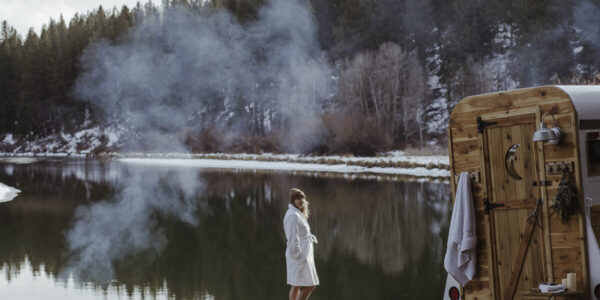

Naturalist and artist Obi Kaufmann is on a mission to help us all get back to the land.
You know you’re in the right place when Obi Kaufmann begins to describe the surrounding landscape as “generous.” Spend enough time, and in the right place, with this modern-day John Muir and you’ll start to see the world around you differently, more vividly.
For the California native, the Earth, and the animals and plants on it, are indeed generous—if you know where to look, when to look, and how. Today, he’s taken the editors of Sunset on a camping adventure in our own backyard. We’re hanging out in the juniper, sage, and pine trees near the top of Mount Diablo State Park, just 30 miles east of San Francisco. “I cut my teeth as a naturalist in this wholly singular place,” says Kaufmann, who was born in Hollywood but spent his childhood exploring this mountain. “Surrounded by suburban development, this is an important jewel of local wilderness. I have a deep relationship to it. It’s not that it’s my mountain, in fact I am sure it is the other way around. I belong to it.”
In 2009, Kaufmann walked away from a burgeoning career as a gallery artist and hit the trail full-time with his watercolors. The sketches began to flow, as did the hand-painted cartography that would become Kaufmann’s opus, The California Field Atlas. Published in 2017, the book is Kaufmann’s thesis writ large—a 552-page volume of heirloom-quality heft with hundreds of hand-painted maps and renderings of the state’s flora and fauna.

Thomas J. Story
Now in its fourth printing, the book is an inroad to knowing the natural world of California. “Nature in California is so deep and complex, I could paint a hundred maps a day for the rest of my life and never tell the whole story I wanted to tell,” says Kaufmann, who has a series of books coming out on California natural history, each one on its own topic: water, forests, coasts, deserts, and fire.
We’ve come to the site of Kaufmann’s creation myth, Mount Diablo’s craggy summit. In all directions, California extends out from this isolated, 3,849 foot peak. From up here, in the golden hour, just before the sun slips through the goal posts of the Golden Gate on the western horizon, you get much of the state laid out like a plate in 360°. After a day of hiking, we head down from the peak, windblown and pleasantly spent, and scramble back to camp to build a fire before it gets too dark.
Around the flames, we ask him about his enviable lifestyle on the trail. Kaufmann spends more days in the summer without a roof than with one. But he reminds us that the outdoors does not have to be far from home, nor does it have to be hard-core. “I am not a peak-bagger. I don’t go in for all that technical gear,” he confesses. “I prefer to amble through river valleys, following the contour lines more than crossing them.”

Thomas J. Story
You may not be as fortunate as Kaufmann to spend most days in thrall to Mother Earth. But shouldn’t you get more from your relationship with her? We asked Kaufmann for his advice on getting the most from your time outside.
1. Take it slow.
“Nature doesn’t reveal itself at 65 miles per hour. Walking is important, stopping even more so. Backpack at an ambling rate. Stop by the creek and study the birds. Break out the journal and the binoculars often.”
2. Broaden your view.
“My books explain how larger, living forces work together and coalesce to form nature’s bigger drama. Widen the lens, investigate larger trends in the ecology around you. If you want to learn natural history, for example, start with a family of plants or birds; don’t start with an individual species.”
3. Read a book.
“Books are trails that uncover the nature of thought itself. Some of the best nature writers in history are alive today: David Rains Wallace, Gretel Ehrlich, Terry Tempest Williams I hang on their every word.”
4. Join a Land Trust.
“This apolitical network is working to preserve the natural character of millions of acres across the West. Provide support with dollars and volunteering. Doing some trail work or cleaning up a trashed site is about as satisfying a day in nature as can be had.”
5. Reconnect with nature.
“The number one thing you can do to help defend the wild spirit of nature is to take care of yourself. Go outside. Take off your shoes. Feel the grass in your toes. Take a moment to observe the bird, or the flower, or the passing cloud and marvel that you are the eye of the living universe perceiving the thing of the living universe. You, yourself are the natural world.”
Obi Kaufmann’s most recent book The State of Water, Understand California’s Most Precious Natural Resource came out June 1, 2019. Follow Obi @coyotethunder.